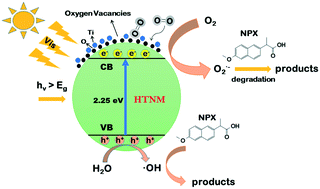Photocatalytic degradation of naproxen by a H2O2-modified titanate nanomaterial under visible light irradiation†
Abstract
Titanate nanomaterials (TNs) have been widely used in organic degradation and photocatalysis due to their large specific surface area, high activity and outstanding ion exchange capacity. However, TNs have a weak response to visible light, and the mechanism of photodegradation of PPCPs by various TNs under visible light is still poorly understood. At the same time, metal modified TNs have a potential secondary pollution problem in aquatic environments. Here, we report on an efficient TN photocatalyst modified with H2O2 (HTNM), which exhibited an enhanced photoresponse to visible light and a highly improved photocatalytic activity. The prepared samples were characterized using X-ray diffraction (XRD), field emission scanning electron microscopy (SEM), Brunauer–Emmett–Teller (BET) surface area measurement, UV-visible diffuse reflectance spectroscopy (UV-vis DRS) and X-ray photoelectron spectroscopy (XPS). The degradation effect, influencing factors, quantum yield, reaction kinetics and intermediate product transformation pathways of naproxen (NPX) degraded by the HTNM were systematically studied, and the degradation mechanism of NPX by the HTNM was also investigated. The results show that the absorption of visible light and the photocatalytic activity can be improved remarkably by H2O2-modification of TNs. Under visible light, the removal rate of NPX by the HTNM can reach 99.9% within 180 min, the degradation rate was fitted with a pseudo-first-order kinetic model, and the catalytic activity was stable. The photodegradation of NPX was inhibited by Cl−, CO32−, SO42− and NO3− in aqueous solution. Among these ions, NO3− had the greatest impact on the degradation of NPX, and the following were CO32−, SO42− and Cl−. The common humus in water, fulvic acid (FA), would decrease the degradation rate of NPX, while humic acid (HA) could promote the photocatalytic degradation of NPX. The mechanism study showed that ˙OH and O2˙− were mainly involved in the photodegradation of NPX by the HTNM, and decarboxylation and hydroxylation were the main pathways of NPX degradation. In summary, the HTNM offers a better photocatalytic degradation route compared with pristine titanate for removing NPX in aquatic environments, provides a new idea for treatment of wastewater contaminated with NPX and has a broad application prospect in aquatic environments.

- This article is part of the themed collection: 2019 Catalysis Science & Technology HOT Articles


 Please wait while we load your content...
Please wait while we load your content...